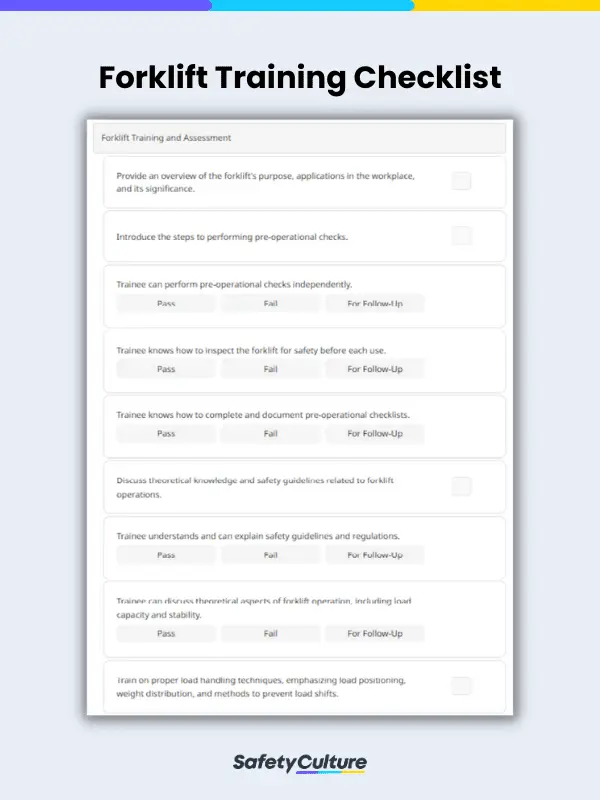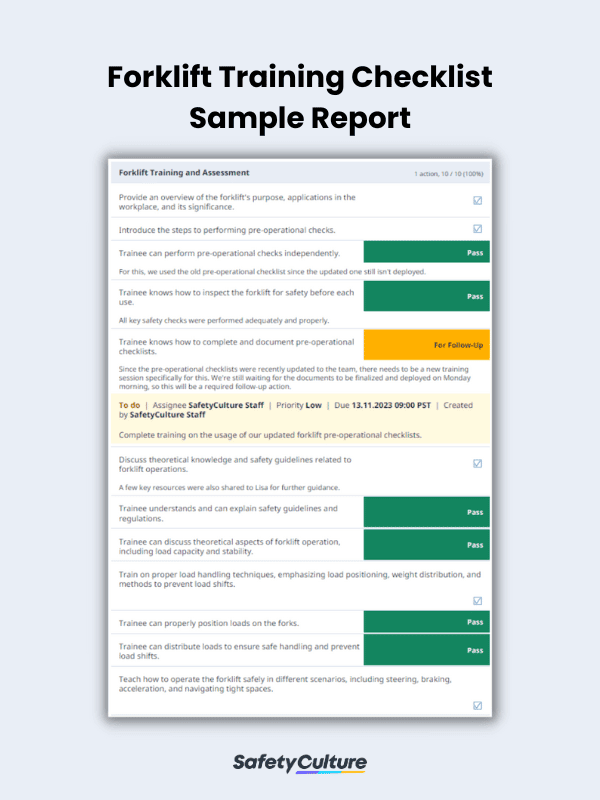What is a Forklift Training Checklist?
A forklift training checklist is a structured document or tool that outlines the key components and steps required to train individuals in the safe and efficient operation of forklifts. It serves as a comprehensive guide for forklift trainers, instructors, and trainees to ensure that all necessary topics and skills are covered during the training process. The checklist typically includes a series of tasks, safety procedures, and knowledge assessments that must be completed or understood by trainees to demonstrate their competency in forklift operation.
Why Use a Forklift Training Checklist
By systematically covering all critical forklift safety procedures and practices, forklift training checklists help reduce the risk of accidents, injuries, and property damage. It ensures that trainees receive comprehensive training on topics such as pre-operational checks, load handling, and emergency protocols, instilling a strong workplace safety culture among forklift operators.
Apart from that, the following are also key benefits of incorporating the use of checklists when conducting forklift training:
Regulatory Compliance
Forklift training checklists play a crucial role in ensuring compliance with regulatory agencies’ requirements, such as the Occupational Safety and Health Administration (OSHA) in the United States. Using a checklist demonstrates a commitment to meeting and exceeding these standards, reducing the likelihood of fines and legal liabilities. It also helps in maintaining proper documentation, which is often essential during safety inspections and audits.
Similarly, using such checklists helps organizations in various regions comply with respective standards and guidelines, including the following:
Improved Operator Competence
A forklift training checklist helps operators build competence in various aspects of forklift operation, from understanding safety principles to performing pre-operational checks and handling loads. Ultimately, improved competence leads to more efficient and safe forklift operations.
Documentation and Accountability
Proper documentation of training sessions can help track the progress of trainees, providing evidence of training for compliance purposes and offering a record of who has completed the training. This allows organizations to manage and monitor their training programs effectively.
What to Include in a Checklist for Forklift Safety Training
A forklift training checklist is a crucial tool used to cover all essential elements of training are covered. It helps trainers and trainees maintain a focus on safety and competence in forklift operations.
Hence, make sure to include the following items in your checklist:
- Trainer and Trainee Information
- Pre-Operational Checks
- Theoretical Knowledge and Safety Guidelines
- Load Handling Skills
- Maneuvering and Navigation
- Fueling and Maintenance
- Pedestrian Safety
- Emergency Procedures
- Final Assessment and Sign-offs
Remember that the checklist can be customized to meet the specific needs of your workplace and the types of forklifts in use. By including these general elements and sections, you can ensure that the most common areas and topics are tackled in your forklift training program.
Steps to Creating an Effective Forklift Training Checklist
Creating a checklist to help improve your forklift training program is a crucial part of ensuring the safety and competence of forklift operators. Hence, follow these key steps to develop a comprehensive and efficient one:
- Clearly define the goals and learning objectives of your forklift training program, such as promoting safety, meeting regulatory requirements, and enhancing operator proficiency. This way, you can incorporate elements and sections that are relevant to your objectives.
- Be familiar with local, state, and federal regulations governing forklift operations, as your checklist should align with these standards.
- Collaborate with experienced forklift trainers and operators within your organization to gather insights into the practical aspects of training and identify critical topics.
- Identify the essential components and topics that should be covered in your training program, including pre-operational checks, safe maneuvering, load handling, and emergency procedures.
- Arrange the checklist items logically, ensuring a smooth flow of training, from theory to hands-on practice and from basic to advanced concepts.
- Periodically review and update your checklist to stay current with changing regulations, equipment, and safety practices, ensuring the checklist remains effective.
How to Fill Out One
Filling out a forklift training checklist systematically captures the trainee’s progress, and the checklist serves as a valuable record of their training.
To guide you through the process, here’s a straightforward guide to filling it out:
- Begin by recording the trainee’s name, employee identification or certification number, and the date of the training.
- Document the trainee’s ability to perform pre-operational checks, ensuring they can inspect the forklift for safety before each use.
- Assess the trainee’s understanding of safety guidelines, regulations, and theoretical aspects of forklift operation.
- Evaluate the trainee’s capability to handle loads safely, including proper load positioning and weight distribution.
- Record the trainee’s performance in maneuvering the forklift, such as steering, braking, and navigating tight spaces.
- Gauge the trainee’s awareness and adherence to safety practices when working near pedestrians and in shared spaces.
- Ensure the trainee knows how to respond to common emergencies, like equipment malfunctions or accidents, and document their proficiency in these situations.
As an example, check out this completed forklift training report exported as a PDF file:
FAQs About Forklift Training Checklists
The legal requirement to use a forklift training checklist can vary by region and is typically governed by local, state, and national regulations. In many jurisdictions, the use of a forklift training checklist is mandated as part of workplace safety regulations.
For instance, in the US, OSHA requires employers to provide training and ensure that forklift operators are competent. Using a forklift training checklist is a common practice to meet these requirements and maintain a documented record of training.
Yes, these checklists can be adapted and used for different types of forklifts. While the core principles of forklift safety and operation remain consistent, there may be variations in the checklist items to address the unique features and requirements of specific forklift types.
Customizing the checklist ensures that trainees receive training that’s directly relevant to the type of forklift they will operate, addressing the specific challenges and safety considerations associated with that equipment.
Evaluating the effectiveness of forklift training checklists is important so that the training program achieves its intended goals and promotes safety. Here are some best practices to consider:
- Regular reviews and revisions
- Incorporating feedback from trainers and trainees
- Compliance with regulatory standards
- Tracking training records
- Periodic reevaluation
- Continuous improvement




